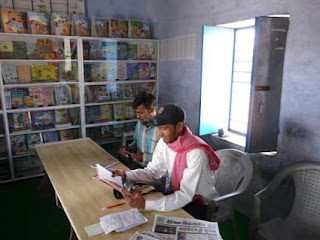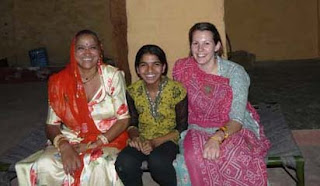I wake up at around 6am. The electricity goes off at 5am so by 6 the room has started to heat up. I'm normally asleep by 10pm so still get my 8 hours even when I wake up so early. It's funny to think that back in Bristol I would beg Rob not to set the alarm for 6.30am because it felt so early. My new mother wakes up at 4am to milk the cows and start cooking the vegetables for breakfast. She said last week that she was annoyed at her eldest daughter for sleeping in until 7.30am! Anyway, if I'm feeling good I quickly get washed and dressed into my Indian themed running wear, which I'm sure is inappropiate consisting of salwars, a t-shirt and my karrimor trekking shoes. I have to walk to the edge of the village so that the rabid dogs don't get excited and decide to chase me then I run 2.5kms to the Jungle Shelter, essentially a concrete roof which was set up as a meeting point on the boundary between two villages. I wash my mouth out with water from the hand well, being careful not to swallow it, then run the same distance back home usually thinking about how dusty and dry the air is. As a strange running foreigner I attract attention from the locals and some boy envitably comes up to me and says "you are running madam". "Yes" I say.

By the time I get home it's 7am and the sun is coming up fast. I do some yoga outside my room to stretch after my run then go and sit with the family by the cooking area for some chai, being careful to sit in the shade. Then it's usually time for some clothes washing, or general phaffing in my room, some breakfast and a nice bucket shower before I begin work at 9.30am ish. In India the key word for arranging to do something is always 'ish', you get used to it. If the electricity, and therefore the air conditioning doesn't come on until 11am, it's a sweaty couple of hours but at least my brain still functions. Air conditioning, when the plug doesn't blow up or the electricity doesn't cut out, is my saviour. Luckily my desk is quite close to the wonderful machine so I feel pleasantly cooled and am able to crack on with work. 1pm and it's lunch and I rush to the almeree (food storage cupboard) to grab my tiffin box and rush back to my room, turn on the cooler and fan and sit at my desk eating lunch and reading something. The real treat comes when I get to lie on my bed, read and have a quick nap. I dreamt of day time nappiing in my last job and I'm living the dream!

Back to work but I know by 4pm, or perhaps before, the electricity would have gone and for those two hours between 4pm and 6pm when I leave the office my brain will slow and my productivity level will drop right down. And this is a good day. Sometimes the power goes at 2pm so the whole afternoon is spent in a hot office with no relief. I couldn't count the number of emails I send home with updates on whether the power is on and the AC is working at that particular moment. I'm told alot of the power comes from hydroelectic, and as there hasn't been much water in the last couple of years, not only is there severe water shortages but there's limited power too. We are incredibly lucky to have our own well with fresh, clean water pumped from deep within the ground to our taps. In Jaipur women fight to have access to the government water aid trucks, and the mains water only comes on in the morning for a couple of hours and perhaps only gives 20 litres per house.

6pm and I drop my things off in my room and go and sit with my family around the cooking area again being careful to sit in the shade. Perhaps I'll go and look at the cows and play with my new favourite friend, a cute 2 year old girl called Sumni who calls me Didi, meaning big sister. 7pm and it's dinner time, the temperature is quite pleasant and the power comes on around 7.15pm, so after dinner I take my cup of freshly boiled milk to my room, turn on the cooler and fan and enjoy the cool, albeit a very noisy, wind tunnel sounding cool. By bed time sleep comes easily. In the early hours it's cool enough to have a blanket on.
My new family say they are surprised how well I'm adapting to the new climate, the heat and a new environment. So how do I survive the heat? I try not to go outside during the day, I take things easy and I dream of the winter when I'll have to wear a jumper. If I do have to spend a day in the open, I make sure my head and neck are covered with a big white cotton cloth which is a village essential here, wear sunscreen and obviously make sure I drink lots of water. It's a dry heat here, and I knew I was good with desert heat, much better than the humid heat you find in South East Asia. I've almost done one month and each successful day does feel like an achievement. It won't be long until the cool, when we'll be thinking of heaters not coolers, knit wear not the thinest cotton you can find.




























